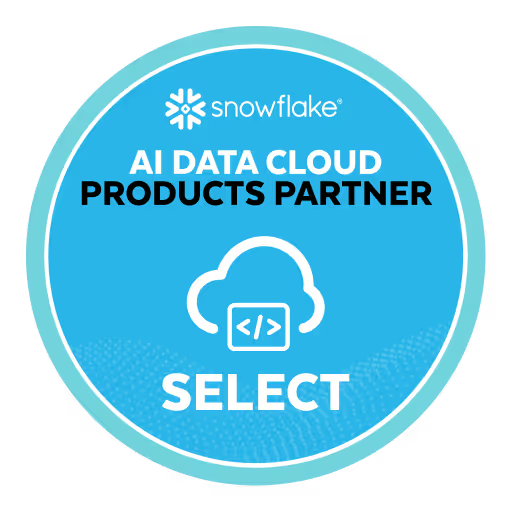Snowflake's cloud data platform has revolutionized how companies handle their data. Its pay-per-use model allows scaling resources based on actual needs, eliminating fixed infrastructure investments. This flexibility comes with a caveat: costs can quickly spiral beyond expectations without proper management.
Many organizations struggle with Snowflake spending because they can't see consumption patterns, haven't optimized their queries, or lack structured governance approaches. The same flexibility that draws businesses to Snowflake requires attentive monitoring to keep expenses predictable and reasonable. In this blog, we cover a brief understanding of the snowflake cost structure and learn about the 9 common pitfalls in snowflake data spend management.
Understanding Snowflake's Cost Structure
Getting a handle on Snowflake's spending requires familiarity with its three core pricing components:
Compute Costs (Virtual Warehouses)
Virtual warehouses handle all query processing and typically represent the largest expense for most organizations. Snowflake calculates these costs based on warehouse size (ranging from X-Small to 6X-Large), active running time (billed in seconds with a one-minute minimum), and concurrent warehouse usage. Each size increase doubles both processing power and cost, making right-sizing a critical cost control factor.
Storage Costs
Storage expenses include your compressed data, Time Travel and Fail-safe storage for historical data recovery, and space used by database objects such as tables and views. While generally lower than compute costs, storage expenses accumulate over time, particularly when data retention isn't managed strategically.
Data Transfer and Egress Fees
Data movement between regions, clouds, or in and out of Snowflake incurs charges that are often overlooked until bill review time. These costs become particularly significant for global operations or multi-cloud deployments, where data regularly crosses regional or provider boundaries.
9 Common Pitfalls in Snowflake Data Spend Management & How to Avoid Them
1. Improper Warehouse Sizing
The Problem: Organizations frequently choose warehouses that are too large "just in case" or too small to save money. Both approaches backfire. Oversized warehouses waste resources on queries that don't need the power, while undersized ones create performance bottlenecks and frustrate users.
How to Optimize:
- Begin with smaller warehouse configurations and scale up when data shows it's necessary
- Monitor query execution patterns to determine appropriate sizing
- Set up auto-scaling for workloads that fluctuate throughout the day
- Assign different warehouse sizes based on workload types – smaller for straightforward reporting, and larger for complex transformations.
- Compare performance-to-cost ratios when testing warehouse upgrades.
2. Over-Provisioning & Under-Provisioning Compute Resources
The Problem: Beyond basic sizing issues, many teams struggle with holistic compute management. Warehouses sit idle but running, auto-suspension settings remain at default values, and peak-hour patterns go unaddressed.
How to Optimize:
- Adjust auto-suspension timing based on actual usage patterns
- Implement stricter suspension policies during off-hours
- Schedule intensive processing during low-demand periods
- Deploy multi-cluster warehouses for handling variable user loads
- Review and optimize warehouse assignments for different user groups
- Implement resource monitors with credit quotas
3. Inefficient Query Performance & Design
The Problem: Suboptimal queries drain resources and inflate costs. Common culprits include unnecessary table scans, missing filters, inefficient join operations, and poorly optimized user-defined functions.
How to Optimize:
- Review query profiles to spot problematic patterns and execution plans
- Apply filters early in query execution to reduce data processing
- Select clustering keys that match your most common access patterns
- Structure joins around clustered columns when possible
- Create materialized views for frequently run complex queries
- Select specific columns rather than using SELECT * statements
- Use EXPLAIN PLAN to analyze query performance bottlenecks
- Leverage query tags to track resource usage by application
4. Poor Storage Management
The Problem: Unchecked data growth drives storage costs skyward as organizations accumulate duplicate, outdated, or rarely used information at premium rates.
How to Optimize:
- Create access-based data lifecycle policies
- Configure Time Travel retention appropriate to actual recovery needs
- Move older data to lower-cost storage tiers
- Compress text-heavy fields before storing
- Use transient tables for temporary processing
- Implement a data retention policy with automated cleanup processes
- Consolidate small files using COPY commands with appropriate file formats
5. Excessive Data Transfers & Cross-Cloud Costs
The Problem: Moving data between regions or cloud providers generates substantial charges that often go unnoticed until billing review.
How to Optimize:
- Position Snowflake accounts in the same regions as your primary data sources
- Consolidate smaller transfers into larger batches
- Implement Snowpipe for streamlined incremental loading
- Refine multi-region replication strategies
- Apply compression before transfer to reduce data volume
- Consider using Snowflake Data Marketplace for commonly shared datasets
- Analyze cross-region query patterns and optimize accordingly
6. Lack of Cost Monitoring & Governance
The Problem: Without systematic oversight, expenses multiply rapidly, especially in environments where multiple teams access Snowflake independently.
How to Optimize:
- Implement resource monitors with automated alerts and quotas
- Connect access roles to cost centers
- Create dedicated warehouses for specific departments or workload categories
- Use account usage views for detailed consumption tracking
- Schedule regular expense reviews with stakeholders across the organization
- Create custom dashboards using ACCOUNT_USAGE and INFORMATION_SCHEMA views
- Implement tagging strategies to attribute costs to business units
7. Misuse of Non-Warehouse Compute Resources
The Problem: Many teams focus exclusively on warehouse spending while overlooking other compute costs from Snowpipe operations, automatic clustering, materialized view maintenance, and search optimization services.
How to Optimize:
- Track all compute usage comprehensively, not just warehouse costs
- Be selective with automatic clustering implementations
- Choose clustering keys thoughtfully based on actual query patterns
- Evaluate whether materialized views justify their maintenance costs
- Consider the ongoing resource requirements of any automation feature
- Monitor serverless features like Snowpipe and auto-clustering separately
- Create a balanced strategy between warehouse and serverless resource usage
8. Fragmented or Redundant Data Pipelines
The Problem: Organizations often develop multiple overlapping pipelines that process identical or similar data, multiplying compute costs unnecessarily.
How to Optimize:
- Build a central inventory of existing pipelines
- Merge similar ETL/ELT processes where possible
- Develop shared data engineering standards
- Use task orchestration to manage dependencies efficiently
- Build modular transformation logic
- Leverage Snowflake's native Streams and Tasks features
- Implement CDC-based loading over full table refreshes when feasible
- Coordinate pipeline scheduling to prevent resource contention
9. Unused or Rarely Used Database Objects
The Problem: "Data debt" accumulates as tables, views, and other objects consume storage and maintenance resources despite delivering minimal business value.
How to Optimize:
- Monitor object usage patterns through access history
- Schedule periodic reviews of low-activity objects
- Archive or remove tables showing no recent activity
- Convert seldom-accessed tables to external tables on lower-cost storage
- Tag objects with ownership and purpose metadata
- Require expiration dates for temporary or development objects
- Implement automated cleanup procedures based on access patterns
- Develop a formal process for decommissioning unused resources
Advanced Cost Optimization Techniques
While addressing the common pitfalls will significantly reduce costs, these advanced techniques can further optimize your Snowflake spending:
Query Caching Strategy
Snowflake's 24-hour query cache can dramatically reduce compute costs when properly leveraged. Design applications to use identical query text when possible, as even minor differences prevent cache hits. Consider query parameterization rather than dynamic SQL generation to maximize cache effectiveness. Monitor your cache hit ratio through the QUERY_HISTORY view and optimize frequently executed queries first.
Snowflake maintains result sets for 24 hours after a query is completed. Any identical query within that period can retrieve these cached results without incurring additional compute costs. This feature alone can reduce warehouse costs by 15-30% when implemented systematically.
Zero-Copy Cloning for Development Environments
Utilize Snowflake's zero-copy cloning feature to create development and testing environments without duplicating storage costs. This allows teams to work with production-scale data without incurring additional storage expenses. Clone production databases at specific points in time for testing, then discard them when no longer needed.
Unlike traditional database systems that require full copies of data for testing environments, Snowflake's zero-copy cloning creates references to the original data with no additional storage costs until changes are made. This technology eliminates a major cost center for development operations.
Resource-Aware Query Optimization
Beyond basic query improvements, implement resource-aware optimization. Analyze warehouses by workload type and user access patterns. Identify specific SQL patterns that consume disproportionate resources. Consider rewriting problematic stored procedures and UDFs using more efficient logic. Test and benchmark queries with different warehouse sizes to find optimal performance-to-cost ratios.
Advanced organizations are now implementing ML-powered query optimization that automatically identifies and remediates inefficient SQL patterns, potentially reducing compute costs by 25-35% through continuous learning and improvement.
Data Mesh Architecture for Cost Attribution
Implement data mesh principles to align Snowflake costs with business domains. This architecture distributes data ownership across domain-specific teams, making each responsible for their resource consumption. Clear cost attribution drives improved resource usage and creates natural incentives for optimization within each domain.
Progressive organizations have reduced Snowflake spending by 30-40% after transitioning to data mesh architectures with built-in cost accountability and optimization incentives for domain teams.
Proactive Strategies for Managing Snowflake Costs
Beyond addressing specific pitfalls, organizations should implement comprehensive strategies for ongoing cost management:
Setting up Cost Alerts and Budgeting Controls
Create monthly spending thresholds with automated notifications as you approach limits. Program warehouse suspension rules that activate for non-essential workloads when nearing budget ceilings. Build dashboards showing real-time spending against budget to maintain organization-wide visibility.
Using Data Observability Tools for Spend Monitoring
Deploy specialized monitoring tools that highlight cost trends and flag anomalies. Generate regular reports identifying major cost drivers and optimization opportunities. Break down spending by department or team to foster accountability and cost-aware behavior.
Implementing Governance Frameworks for Access Control
Assign clear resource ownership with corresponding cost responsibility. Create standardized approval workflows for adding new warehouses. Document query design best practices. Form a center of excellence that shares optimization techniques across teams.
How Revefi Helps Reduce Snowflake Costs
Revefi is designed by data engineers who know firsthand the pain of managing Snowflake costs. We don’t just watch your spend—we actively help you optimize it with real-time analysis and smart, AI-driven recommendations.
What Sets Revefi Apart
- Deep Insights into Snowflake Usage: Revefi gives you a clear view of query patterns and warehouse utilization that typical monitoring tools miss.
- Actionable Optimization Opportunities:
- Right-Sizing Warehouses: We recommend warehouse sizes based on your actual computational needs, not guesswork.
- Inefficient Query Detection: We pinpoint queries that are driving up costs unnecessarily.
- Dormant Data Identification: We highlight datasets that are using premium storage but aren’t being used.
- Redundant Compute Detection: We spot repeated or overlapping compute operations across teams.
- Automated Recommendations: We provide clear, actionable suggestions with estimated savings.
- Right-Sizing Warehouses: We recommend warehouse sizes based on your actual computational needs, not guesswork.
Unlike generic cost management tools, Revefi is built specifically for Snowflake. Our solution integrates easily with your existing setup—no risky changes or complex architecture required.
Automated Warehouse Management Made Simple
Revefi automates the tedious, error-prone parts of managing Snowflake spend. This means your team can focus less on manual adjustments and more on delivering value.
Want to see how Revefi can transform your Snowflake cost profile and boost performance? Visit www.revefi.com to schedule a custom assessment of your current environment.
Conclusion
Managing Snowflake costs requires addressing technical configurations, governance policies, and ongoing monitoring simultaneously. By avoiding these nine common pitfalls and implementing structured management strategies, you can harness Snowflake's full capabilities while maintaining predictable costs.
The most successful organizations treat cost optimization as a continuous process rather than a one-time project. As your data grows and query patterns evolve, regular evaluation and adjustment of your Snowflake environment becomes essential. Balancing performance needs with cost controls allows you to maximize the platform's value.
Even modest optimizations generate significant savings at scale, making Snowflake cost management one of the most financially rewarding activities for data teams in contemporary data-driven organizations.











